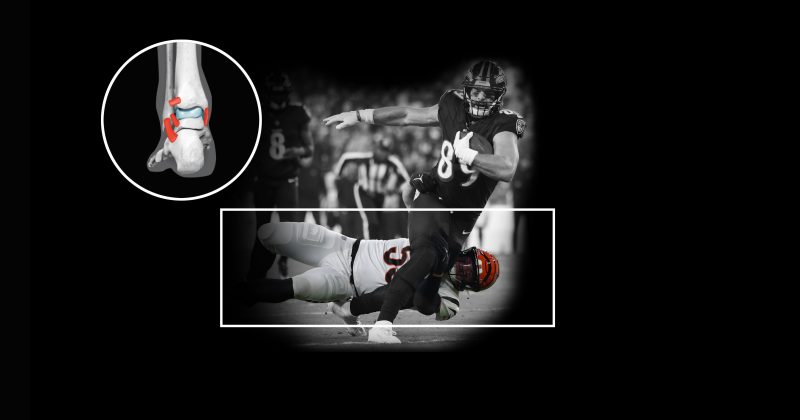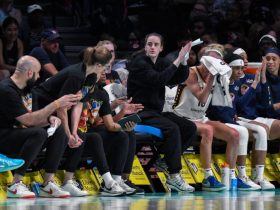A controversial − but still legal − tackle is getting renewed scrutiny after a potentially season-ending injury last Thursday in a game between the Cincinnati Bengals and Baltimore Ravens.
The hip-drop tackle has sidelined Ravens tight end Mark Andrews, who may have sustained a cracked fibula and ankle ligament injury after catching a pass in the game’s opening minutes. While the extent of Andrews injuries remains unclear, let’s clear up what a hip-drop tackle is.
What exactly is a hip-drop tackle?
In a hip-drop tackle, the defensive player approaches from behind or the side, wraps his arms around the offensive player and becomes dead weight while dropping to the ground. Often, the defensive player’s body lands on the offensive player’s legs. According to NFL executive Jeff Miller, it poses a 25-times higher risk of injury than a normal tackle.
Rich McKay, chairman of the NFL’s competition committee, calls the hip-drop tackle the cousin of the horse collar: ‘What’s happening on the hip-drop is the defender is encircling, tackling the runner and then swinging their weight and falling on the side of their leg, which is their ankle or their knee.’
‘A hip-drop tackle is so dangerous,’ said Dr. Robert Glatter, a former sideline physician for the New York Jets and assistant professor of emergency medicine at Lenox Hill Hospital, Northwell Health in New York. ‘The defender essentially swings their full body weight as they fall on their ankle, leg or knee. This leaves the lower body at risk for serious ankle and ligament damage.’
How did Mark Andrews get injured by a hip-drop tackle?
Andrews’ injury occurred during the first quarter of Thursday night’s game when Bengals linebacker Logan Wilson tackled him from behind.
Early this week, Ravens coach John Harbaugh was cautiously optimistic about Andrews’ injury: ‘Nothing is completely definitive yet, but my understanding is in talking with our trainer and the doctors is that it wasn’t as bad as initially feared right after the game.’ The Associated Press reported Tuesday that Andrews had surgery earlier that day, but details on the level of injury were not available.
Initial reports were that Andrews suffered a fibular fracture with ligament damage. ‘A fibular fracture with ligament damage is likely a season-ending injury in the best of circumstances,’ Glatter said.
Ankle fractures are classified into three main categories, according to the Danis-Weber classification system:
Bengals coach Zac Taylor defends Wilson
Bengals coach Zac Taylor defended Wilson. ‘One thing that’s frustrating was the narrative that’s been brought up about Logan Wilson,’ Taylor said. ‘Logan is everything we want to be about in the way he plays the game. He plays with a toughness and a physicality that is important to that position.’
A person with knowledge of NFL’s competition committee, who asked not to be identified, told USA TODAY Sports that at least one member of the committee in recent days has suggested the highly unusual measure of instituting a rule during the season and banning the hip-drop tackle. The person asked not to be identified because of the sensitivity of the issue.
Other notable injuries from hip-drop tackles
In Week 4, Seattle Seahawks quarterback Geno Smith suffered a knee injury during a Monday night game when Isaiah Simmons hip-drop tackled him. Ironically, referees flagged Smith for a personal foul when he got into a scuffle with Simmons after the play.
‘A dirty play,’ Smith told ESPN’s Lisa Salters after the game. ‘There’s no place in the sport for that. And you know, hopefully something happens. But other than that, the grace of God allowed me to come back into this game.’
Other recent injuries of note caused by the hip-drop tackle:
Cowboys running back Tony Pollard suffered a fractured leg and ankle in January and was knocked out of an NFC divisional playoff game at San Francisco.Kansas City Chiefs MVP quarterback Patrick Mahomes suffered a high ankle sprain that same weekend during the AFC divisional playoff. Mahomes’ injury could have been worse. ‘While a ‘high ankle sprain’ or injury to ligaments above the ankle can result from such a tackle, associated fractures involving the fibula can also occur related to the rotational or twisting type of injury,’ Glatter said.
During league meetings in New York last month, an NFL executive Jeff Miller contended that the injury rate linked to hip-drop tackles is 25 times higher than for a normal tackle. That’s an uptick from the “20 times higher” figure NFL executive vice president Troy Vincent cited during the spring.
Recent rules created to protect players
If the league were to impose a rule against the hip-drop tackle, it wouldn’t be the first time it has cracked down on risky defensive plays. Among them:
Horse-collar tackle: During the 2005 off-season, NFL owners voted to ban the play in which a defender grabs the inside collar of the back or the side of the shoulder pads or jersey and pulls the runner down. Such a tackle leads to ligament tears and tibia and fibula fractures. Other details of the tackle:
It does not apply to a runner who is in the tackle box or a quarterback still in the pocket.A player doesn’t have to be to pulled to the ground for the tackle be considered illegal. If his knees are buckled by the action, it’s a foul.
Helmet to helmet: In 2018, the league imposed a helmet rule that bans players from lowering their heads and making forcible contact with their helmet. The foul can happen on any part of the field, and in some cases, the player can be disqualified.






